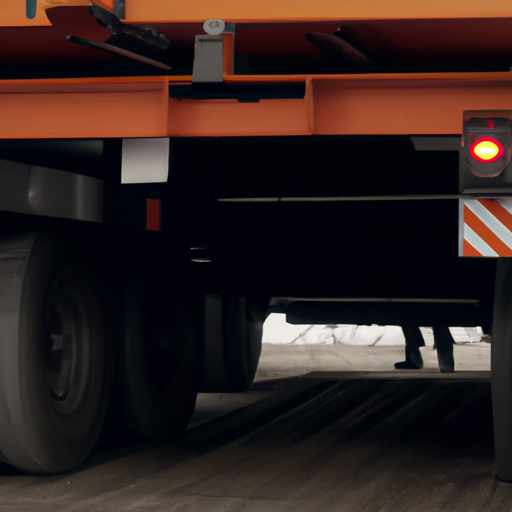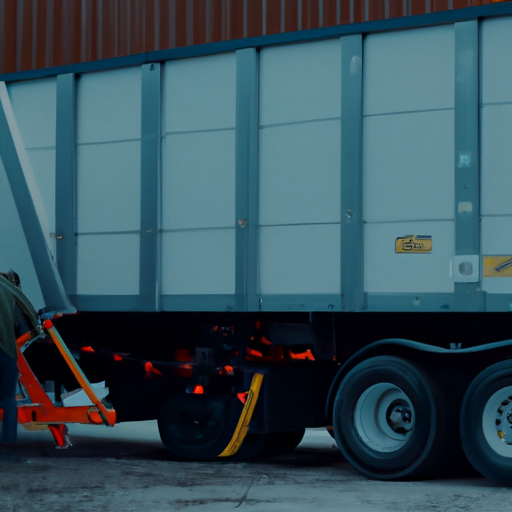-
Table of Contents
Introduction
Conducting a safety inspection for your heavy duty dump trailer is a vital task to ensure the durability of your equipment, provide optimal performance during operation and to minimize risks and accidents in the workplace. This guide will walk you through key steps to do this properly, encompassing areas such as checking structural integrity, examining hydraulics system, inspecting brake systems & lighting equipments along with validating proper load capacity. Adherence to these inspections not only maintains overall operational safety but also ensures compliance with regulatory standards.
Proper Steps to Conduct a Safety Inspection for Your Heavy Duty Dump Trailer
Every successful journey begins with thorough preparation, and this sentiment applies to operating heavy duty dump trailers as well. These heavy-duty machines that play an integral role in the automobile and construction industries need regular maintenance checks or safety inspections for them to function efficiently. While it might seem like a complex task initially, conducting these checks isn’t rocket science once you know what to do.
Firstly, let’s start from where every drive starts; the hitching mechanism of your trailer. This crucial feature determines whether your truck is connected securely to the trailer or not. Prioritize checking the coupler for any signs of wear and tear regularly because even minor impairments can have significant consequences. You should also examine if nuts and bolts are tight enough since loose connections can lead to disastrous accidents.
Now that we’ve ensured a secure connection between your trailer and truck let’s shift our focus towards safety chains. These act as added security by ensuring that even if your main coupling fails due to unforeseen circumstances, these chains will protect both vehicles from separating dangerously on busy highways. Therefore, inspecting their integrity becomes paramount during a safety check.
Moving onwards, let’s delve into another vital area; tires of your dump trailer bear immense weight loads making them prone to deterioration faster than other components—monitor their air pressure levels frequently using high-quality tire gauges reliable readings. Check consistently for sidewall bulges or tread separations since they may indicate potential blowouts—an undesired occurrence during drives laden with precious cargo!
Making sure everything is running smoothly so far? Fantastic! Now it’s time we switch our attention towards brakes — arguably considered among one-of-the-most essential parts when dealing with massive vehicles like dump trailers often loaded beyond typical weights limits at times creating challenging driving conditions such extraordinary needs require impeccable braking system functioning seamlessly all times testing such systems usually involves checking lines hoses leaks furthermore brake shoes engaging properly without sticking releasing freely drums exhibiting heat-related issues guide how decisively your trailer-carrying hefty loads stops when signaled.
After we’ve got the braking system covered, the next step is to inspect the hydraulic and lifting systems. The primary purpose of a dump truck is to move heavy material from one place to another safely and efficiently. Therefore, it’s crucial that these systems are in good working order for safe operation. Regularly check fluid levels in hydraulics and lubricate moving parts for longevity.
By now, you might be thinking about what else could possibly be left? Well, this brings us to lighting and signals on your trailer – they enable communication between yourself and other drivers on road comprehending these signs correctly vital thus during safety inspection check all internal external lights including taillights brake indicators ensuring they’re functioning optimally—this measure will keep you legal visible roads no matter hour!
Finally yet importantly emphasis must also laid exterior body dump trailers ensure there aren’t cracks deformities resulting structural weaknesses while major physical impairments easily noticeable minor ones often overlooked consequently regular thorough inspections imperative identify fix issues early stages preventing potential catastrophic failures future.
Conducting a safety inspection can seem daunting initially but with practice patience become second nature remember prevention better than cure – this adage holds much water especially true context operating heavy-duty dump trailers make habit conducting regular checks not only improve productivity lower maintenance costs but more importantly provide safe environment everyone involved from driver passersby roads alike taking time do right thing never wasted let’s strive safer tomorrow efficient proactive measures today happy hauling!
Essential Checklist: How to Safely Inspect Your Heavy Duty Dump Trailer
There’s no disputing that when it comes to hauling heavy loads, a heavy-duty dump trailer is an indispensable asset. However, regular safety inspections are crucial to ensuring your trailer remains not only functional but also safe for use. A thorough inspection of your dump trailer safeguards you from avoidable mechanical breakdowns and potential accidents.
So where do we start with these essential checks? Before anything else, proper personal protective equipment (PPE) should be sourced and used during the inspection process. It ensures that you remain safe while inspecting potentially hazardous parts of the dump trailer.
In general terms, visual inspection should always kick off the process. Look out for any noticeable signs of wear and tear or structural damage on all surfaces visible to the naked eye. Pay attention to areas like welded joints which are susceptible to stress, resulting in cracks or breaks.
Next up is assessing the hydraulic system – heartbeat of any heavy-duty dump trailer operation. Leaks pose a grave risk because they can lead to unexpected pressure drops leading possibly even failure during operations – something none of us wants! Inspecting hoses for cuts or bulges is critical as such signs might signal imminent failure due to internal pressure build-up.
Checking tires’ condition follows next as worn-out or under-inflated tires affect maneuverability significantly posing serious safety hazards. Ensure that tire treads aren’t excessively worn down: if ‘wear bars’ become visible across treads on one/multiple tires then it time for replacement; remember keep them properly inflated too according manufacturer’s guidelines!
Interestingly enough moving onto brake systems may seem tedious but believe me its importance cannot understated high-speed situations require optimal braking efficiency stay control prevent mishaps.
Ensure tie rods securely fastened tightly adjust slack cables activation lever needs at position intended by design specifications enhancing operational accuracy reliability brakes activating appropriately without sticking.
From there move electrical system especially trail lights essentially enhance visibility road users likewise allows clear communication intentions others maintaining overall traffic harmony safety. Faulty trail lights lead accidents particularly night or terrible weather conditions: inspect corrosion loose connections ensure optimal illumination.
Let’s not forget lifting unloading mechanisms – axle suspension systems contribute significantly overall trailer functionality effectiveness. The former responsible evenly distributing load across tires latter absorbing shocks during transit process making sure each these in top shape will certainly translate into smoother efficient operations.
Lastly grease points need overlooked keeping them adequately lubricated extends overall lifespan dump trailers reducing risk premature wear tear associated with high-stress dumping loading situations. Don’t ignore small fixtures like latches hinges also require regular maintenance prevent rusting jamming.
In conclusion, the principle of prevention is better than cure applies best here. Regular and comprehensive inspections of your heavy-duty dump trailer hitch not only save you from unfortunate incidents but also extend the life span of your investment while ensuring maximum productivity. So keep this handy checklist close to heart as remember that safe working environment is a more productive one!
Guide to Regular Maintenance & Safety Inspections for Heavy Duty Dump Trailers.
Whether you’re using it for personal purposes or within a commercial framework, understanding how to conduct a safety inspection for your heavy duty dump trailer is critical. Regular maintenance and thorough inspections will not only prolong the lifespan of your equipment but also ensure its safe usage. Either way, safety should never be compromised on any grounds.
Initiating this important process begins with an examination of the dump trailer’s tires – their condition can directly influence both functionality and security. Any signs of visible damage like cuts, bulges or excessive tread wear are major red flags indicating that a potential blowout could occur when heavily loaded. Hence, make sure to replace damaged tires immediately. Additionally, correct tire pressure must be maintained as per manufacturer specifications; overly inflated tires pose as much risk as underinflated ones.
Transitioning from there, inspect the brakes next because they play an integral role in safely hauling heavy loads. Test for brake responsiveness while unloaded first and then progressively increase weight to check if there’s any change in performance – remember every load advances another level of danger if the brakes fail to serve their purpose efficiently.
Moving beyond fundamental components like wheels and brake systems brings us towards checking elements such as lights and hydraulics systems which may seem auxiliary but carry equal importance in terms of operational safety. Ensure all lighting including tail lights, turn signals or hazard flashers are working optimally because visibility is pivotal for you as well as other drivers sharing roads during night time or poor weather conditions.
Hydraulic systems need careful review too – look out for leaks around hydraulic lines/hoses & cylinders; malfunctioning parts potentially cause serious accidents due to sudden loss of control/stability over trailers carrying tons worth loads! An effective evacuation plan is obligatory whenever dealing with materials possibly harmful if fallen onto road surfaces i.e., sand/gravel/rocks etcetera…as these situations permit no room negligence whatsoever!
While primarily focusing interior aspects let’s accept external factors hugely contribute towards ensuring safety. For instance, the dump trailer’s hitch system – check carefully whether it is securely attached to your towing vehicle because an unstable connection can result in catastrophic consequences during transit. Additionally, make certain all safety chains are in place and properly adjusted; these add an extra layer of security stabilizing heavy-duty trailers.
Intermittently performing routine inspections may seem daunting yet they enable catching any problems before turning into major issues saving significant amount downtime/money! Also, keeping documentation each inspection helps you maintain a record over time giving valuable insight about specific areas requiring more attention than others leading enhancement overall efficiency reducing chances of serious mishaps or expensive repairs.
To sum up, remaining vigilant towards every minute detail during maintenance/inspection procedures exponentially increases odds protecting both you & your investment from unwanted hurdles. Remember that having a keen eye for potential red flags combined with proactive troubleshooting approach will keep your heavy duty dump trailer running safely and smoothly for years to come.
Q&A
1. Question: What is the first step to conducting a safety inspection on my heavy duty dump trailer?
Answer: The first step is to do a general visual check of your dump trailer, looking for any noticeable structural issues like rust, damage or wear and tear. Check tires for proper inflation and treads, and ensure all lights are functioning properly.
2. Question: How should I inspect the hydraulic system in my heavy duty dump trailer during a safety inspection?
Answer: You should carefully check hydraulic lines for potential leaks or damages. Ensure that the hydraulic fluid levels are correct according to manufacturer’s guidelines. Also confirm that lifting mechanism operates smoothly with no jerking motions as this could indicate possible mechanical problems.
3. Question: What components of braking system must be inspected during safety inspection?
Answer: During a safety inspection, you need to examine brake lining thickness and look for uneven wear which might suggest an issue with alignment or balance; also check brake drum surfaces for cracks or scores; inspect air line connections and hoses for leaks; make sure parking brakes hold when applied; finally inspect ABS (anti-lock braking system) malfunction indicator lamp—if equipped— it shouldn’t illuminate beyond initial power-up cycle.
Conclusion
In conclusion, carrying out a safety inspection for your heavy duty dump trailer involves several steps. Begin by checking the condition of all components such as tires, brakes, hydraulic systems, and electrical connections to ensure they are in good working order. Ensure that the load is well balanced and secured properly before transit to prevent accidents caused by imbalances or shifting cargo. Regular maintenance should be performed based on manufacturer’s guidelines while also taking into account any legal requirements pertaining to vehicular inspections where applicable. By adhering strictly to these measures, safety during operations can be significantly guaranteed thus reducing risks associated with operating heavy-duty dump trailers.


